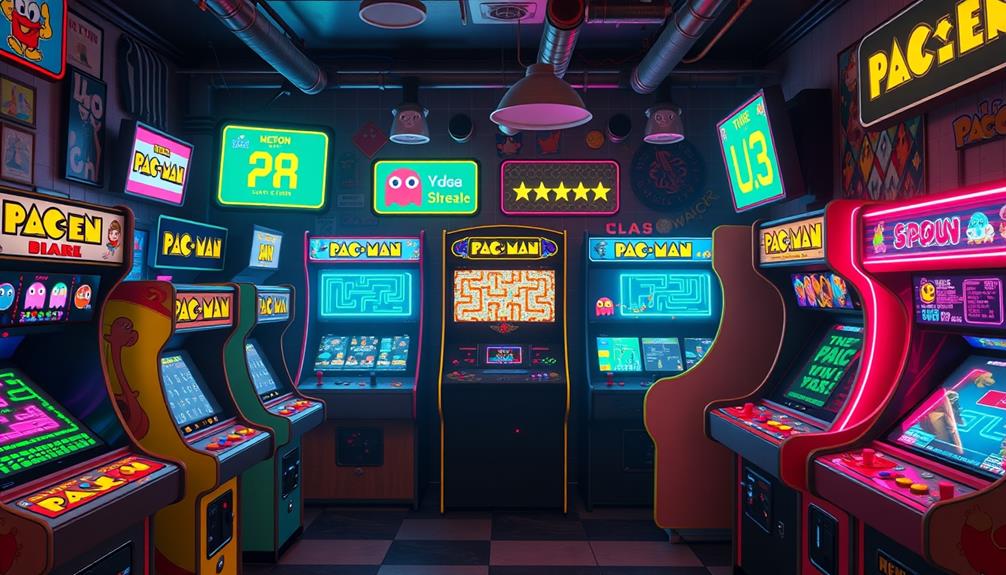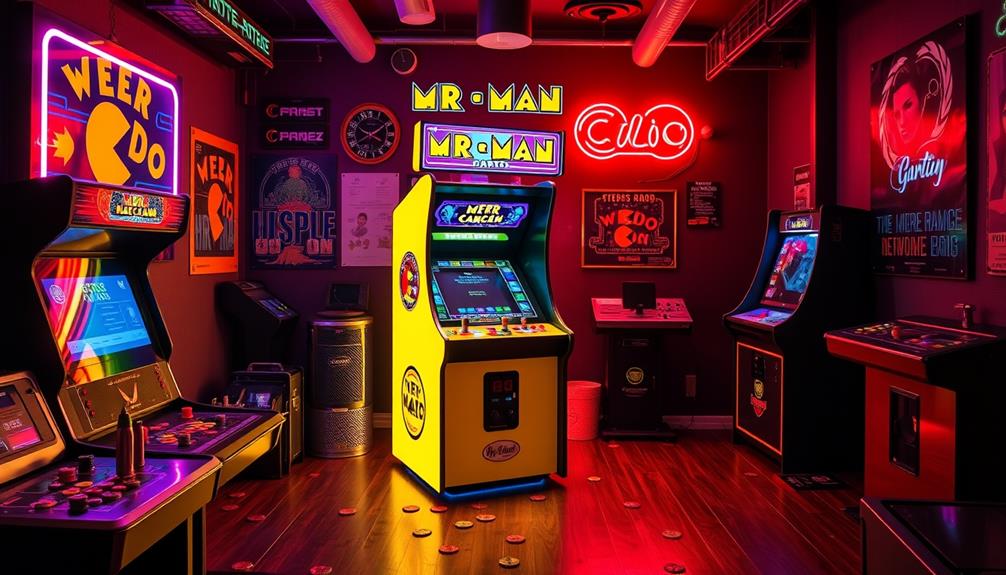If you're a fan of gaming nostalgia, Pac-Man Pixel brings that retro fun right back to you! This iconic character perfectly marries the classic pixel art style with modern gameplay innovations. It taps into your fond memories of the '80s and '90s while offering fresh, engaging experiences. The minimalist design focuses on gameplay, enhancing your overall enjoyment. Today's developers use modern techniques like sub-pixel animation, making these games visually enchanting. Plus, the indie gaming scene embraces this trend, keeping the spirit alive. Curious about how this fusion of old and new is shaping gaming today? You'll want to explore further!
Key Takeaways
- Pac-Man represents a nostalgic gaming experience, reviving memories from the '80s and '90s for modern players through its iconic pixel art style.
- Pixel art's minimalist aesthetic prioritizes gameplay over visuals, making classic mechanics like Pac-Man appealing to both old and new gamers.
- The resurgence of retro-inspired indie games has been fueled by community-driven projects and game jams that celebrate creativity and collaboration in game design.
- Lower resource requirements of pixel art allow smoother gameplay and accessibility across various devices, making it a strategic choice for indie developers.
- The blend of retro and modern gaming elements continues to attract audiences, suggesting a bright future for pixel art and indie game innovation.
Nostalgic Appeal of Pixel Art
What's it about pixel art that tugs at our heartstrings? You might find it's the nostalgia for those early gaming days in the '80s and '90s, when colorful blocks defined your adventures in iconic games like Super Mario Bros. and Pac-Man. The simplicity of pixel art evokes memories of simpler times, reminding you of carefree hours spent mastering levels and sharing laughs with friends.
Today, pixel art isn't just a relic; it's making a comeback. Indie game developers are embracing this unique aesthetic, creating games that blend deep narratives with striking visuals. You see this in titles like Celeste, where the pixel graphics convey profound emotions despite their limited resolution.
The clarity and charm of pixel art allow for rich storytelling in a way modern graphics sometimes miss. Moreover, vibrant communities on platforms like Twitter and Instagram showcase an explosion of creativity, allowing you to discover diverse styles and innovative techniques.
This resurgence keeps the spirit of pixel art alive, connecting you to both the past and the future of gaming. So, whether you're revisiting old favorites or diving into new pixelated worlds, that nostalgic appeal remains ever-present.
Artistic Merits of Pixel Graphics
While many modern games boast intricate 3D graphics, pixel art continues to stand out for its unique artistic merits. This style offers an aesthetic that's both simple and clear, allowing for distinct visual representations that evoke nostalgia and charm.
With limited resolution, pixel graphics convey detail and emotion effectively, creating a more engaging player experience.
Consider these artistic strengths of pixel art:
- Simplicity: The minimalist approach allows players to focus on gameplay rather than overwhelming visuals.
- Creativity: Artists exercise high levels of creativity and precision, placing each pixel with intent to build intricate scenes and characters.
- Nostalgia: The retro aspect brings back fond memories for many gamers, enhancing their connection to the game.
- Innovation: Modern pixel artists, as seen in games like Celeste, push the boundaries of the medium, blending pixel graphics with deep gameplay and narrative elements.
This resurgence in pixel art showcases its enduring appeal and artistic merit, proving that this style remains relevant in today's gaming landscape.
The charm of pixel art isn't just about what you see; it's about the emotions and memories it invokes.
Technical Advantages of Pixel Art
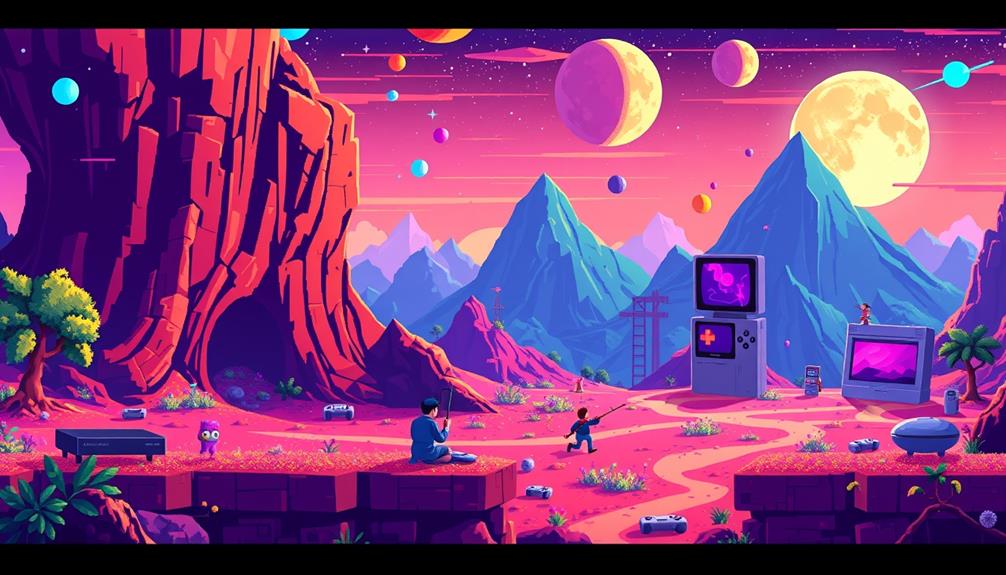
When you think about pixel art, it's clear that its lower resource requirements make it a game-changer for many developers.
By utilizing budget management techniques, developers can allocate their resources more effectively and create engaging experiences more efficiently, allowing for quicker releases and broader accessibility.
Plus, with user-friendly tools available, anyone can jump into game development without needing a massive budget.
Lower Resource Requirements
In the domain of game development, pixel art stands out for its lower resource requirements, making it a practical choice for both developers and players.
Pixel art games typically consume less processing power, which means they can run smoothly on mobile devices and older hardware. This broadens accessibility, inviting more gamers to enjoy these nostalgic creations.
Consider the advantages of pixel art games:
- Reduced Processing Needs: Smooth gameplay on a variety of devices.
- Faster Development: Shorter timelines compared to 3D models, enabling quicker market entry.
- Accessibility of Tools: Software like Aseprite and Pro Motion NG makes game creation approachable for aspiring developers.
- Impressive Visuals: Achieve striking aesthetics while maintaining system efficiency.
Efficient Development Time
Building on the accessibility provided by pixel art's lower resource requirements, developers also benefit from efficient development times. Since pixel art games generally require less processing power, you can focus on creating engaging content rather than getting bogged down in complicated 3D modeling. This simplicity allows you to bring projects to market more quickly, which is vital in today's fast-paced gaming industry.
With shorter development cycles, you can allocate more time to refining gameplay and enhancing player experience. Aspiring developers will find that the availability of user-friendly pixel art tools lowers the barrier to entry, enabling them to immerse themselves in game creation without needing extensive resources or experience.
Moreover, by achieving high-quality visual appeal with pixel art, you can effectively reach a broader audience while maintaining low operational costs. This efficiency not only enhances the viability of your game in the indie market but also helps you stand out among competitors who may struggle with longer development times.
Ultimately, embracing pixel art can be a strategic choice that accelerates your journey from concept to launch, making it a popular option for many developers in the gaming landscape.
Accessibility for Developers
Pixel art provides an accessible entry point for developers, thanks to its technical advantages that simplify the game design process. It offers a unique blend of nostalgia and efficiency, making it an ideal choice for indie developers and small teams.
As the demand for innovative games expands, developers can also explore AI software engineer jobs to enhance their projects with cutting-edge technology. You'll find that pixel art games require considerably less processing power, allowing them to run seamlessly on mobile devices and older arcade cabinets.
This accessibility for developers not only widens your potential audience but also makes it easier to engage with a diverse player base.
Key benefits of pixel art include:
- Shorter Development Time: Create and launch games more quickly than with 3D models.
- Accessible Tools: Software like Aseprite and Piskel democratizes the design process, enabling anyone to get started.
- Lower Resource Requirements: Playable on a variety of platforms without the need for high-end specifications.
- High-Quality Visuals: Achieve appealing graphics while maintaining efficient performance, ideal for small teams.
With these advantages, pixel art stands out as an inviting option for developers keen to create engaging games that can reach a wide audience.
Modern Techniques in Game Design
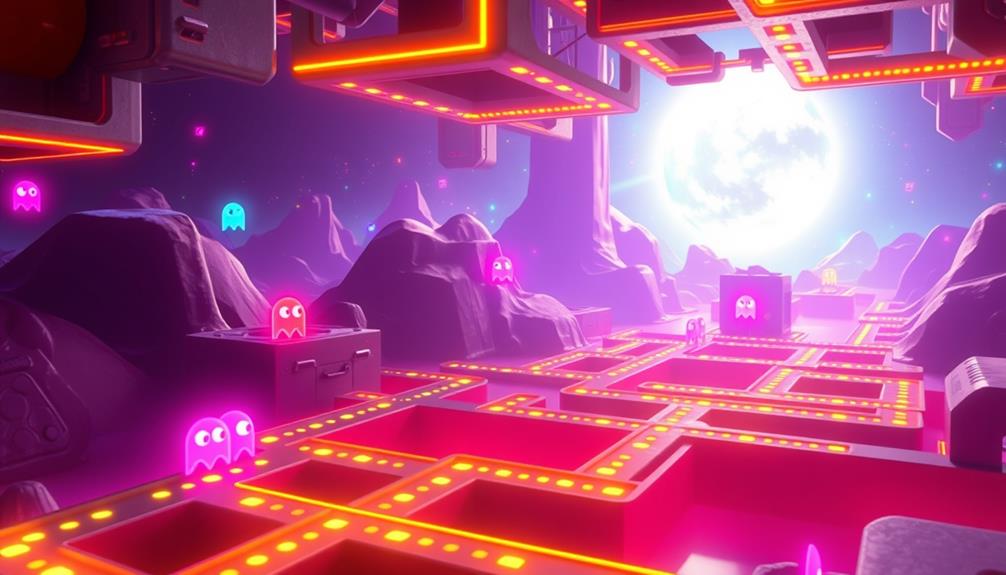
Modern game design has revolutionized how developers create pixel art, utilizing advanced tools like Aseprite and Pro Motion NG to produce stunning graphics with greater efficiency. These modern games leverage techniques such as sub-pixel animation and parallax scrolling, adding depth and dynamism to the visual experience. This means you can enjoy a more immersive gameplay environment, where every pixel plays a significant role.
The success of titles like Stardew Valley showcases how pixel graphics can effectively combine with rich gameplay and narrative depth, appealing to a broad audience. Modern pixel art games push the boundaries of traditional aesthetics, reflecting high creativity and precision in pixel placement. Each scene becomes a canvas, demonstrating the skills and artistry of developers who endeavor to captivate players.
Moreover, the resurgence of pixel art has fostered a vibrant community of artists and developers. By sharing innovative styles and techniques on platforms like Twitter and Instagram, they inspire one another and elevate the gaming experience.
This community-driven approach not only enhances the quality of modern games but also keeps the spirit of retro gaming alive, making it an exciting time for both players and creators alike.
Cultural Impact of Pixel Art
With its vibrant colors and charming simplicity, pixel art has carved out a significant place in gaming culture, bridging the gap between nostalgia and innovation. This artistic style evokes fond memories of early video games like Pac-Man and Super Mario Bros., creating a lasting cultural impact.
You'll find that pixel art isn't just a relic; it's a thriving medium that resonates with both seasoned gamers and newcomers alike.
Games like Hyper Light Drifter and Celeste demonstrate how pixel art can blend with innovative gameplay and meaningful narratives, engaging a diverse audience. The resurgence of pixel art has fostered a vibrant community of artists and developers who celebrate retro and contemporary styles.
Here are some key aspects of the cultural impact of pixel art:
- Nostalgic Appeal: Reminds players of classic gaming experiences.
- Community Growth: Social media platforms amplify collaboration among creators.
- Accessibility: Easy-to-use tools empower aspiring developers.
- Innovative Integration: Merges artistic style with modern gameplay mechanics.
These elements showcase how pixel art continues to shape the landscape of gaming, ensuring its relevance in today's digital world.
Community Engagement and Collaboration

In today's gaming landscape, you can see how building communities around pixel art fosters creativity and collaboration.
By participating in collaborative game development projects, you not only enhance your skills but also contribute to a collective vision that celebrates retro aesthetics.
Plus, engaging on social media platforms can help you connect with fellow creators, sparking new ideas and innovations along the way.
Building Gaming Communities Together
Gaming communities thrive on collaboration and creativity, drawing players, artists, and developers together in a vibrant ecosystem. The resurgence of pixel art in games like Pac-Man has sparked an explosion of artistic expression.
You'll find that platforms like Twitter and Instagram are buzzing with creators sharing their work, leading to diverse styles and innovations.
Community-driven initiatives have birthed exciting indie titles, such as Hyper Light Drifter, which blend retro aesthetics with modern gameplay elements.
Regular events at venues like Quarters Bar + Arcade promote social interaction and a sense of belonging among gamers. These gatherings allow friends to connect and share experiences over their mutual love for games.
Engaging in these communities offers numerous benefits:
- Collaboration: Work with fellow gamers and artists on projects.
- Creativity: Exchange ideas and techniques to enhance your skills.
- Networking: Meet like-minded individuals passionate about pixel art and gaming.
- Competition: Participate in friendly tournaments that foster camaraderie.
Collaborative Game Development Projects
The vibrant energy of gaming communities naturally extends into collaborative game development projects, where fans become creators. In the world of video gaming, this collaboration fuels creativity and innovation, particularly among indie developers.
You'll often see pixel art styles making a comeback, heavily inspired by classics like Pac-Man. Platforms such as Twitter and Instagram act as essential hubs for artists and developers to share ideas and resources, leading to unique artistic expressions in pixel art games.
Game jams are another exciting avenue for collaboration, challenging participants to create projects within a limited timeframe. These events produce distinctive games that blend retro aesthetics with modern gameplay mechanics. Successful titles like Hyper Light Drifter demonstrate how community feedback can shape a game's artistic direction, ensuring it resonates with players.
Moreover, the accessibility of pixel art creation tools empowers aspiring developers to engage with the indie scene. This democratization of game development bridges the gap between retro inspirations and contemporary trends, allowing you to actively contribute to the vibrant landscape of video gaming.
In this collaborative spirit, you're not just a player; you're part of an evolving creative process.
Social Media Engagement Strategies
Three powerful social media platforms—Twitter, Instagram, and Facebook—can elevate your engagement with the gaming community, making it easier for fans to connect and share their experiences.
By utilizing these channels effectively, you can transform the way players interact with Pac-Man and pixel art games.
- Use relevant hashtags like #Pacman and #PixelArt to increase visibility and drive discussions within the gaming community.
- Organize collaborative projects, such as fan art contests or game design challenges, to inspire creativity and deepen community involvement.
- Engage your followers with polls and interactive posts, fostering a sense of belonging and encouraging loyalty to the brand.
- Highlight community achievements, like high score records or standout fan projects, motivating players to engage more deeply and contribute to a vibrant culture.
Social media isn't just about promotion; it's about creating a space where fans feel valued.
By implementing these strategies, you'll not only enhance engagement but also cultivate a loyal community that thrives on creativity and collaboration.
Embrace these tools, and watch your community grow!
Iconic Features of Pac-Man
One of the most recognizable aspects of Pac-Man is its charming design, inspired by a pizza with a slice missing. This friendly character was crafted to appeal to a broad audience, including families and women, which was a revitalizing change in the gaming landscape of the time.
As you navigate the maze, you'll encounter four distinct ghosts—Blinky, Pinky, Inky, and Clyde—each with unique chase patterns. This variety adds depth to the gameplay, challenging you to strategize and adapt your movements.
Collecting pellets and power pills is essential to your success. The power pills, in particular, turn the tables on the ghosts, allowing you to chase them down for extra points. This dynamic keeps the gameplay engaging and exciting, drawing players back for more.
Since its original release in Japan in 1980, Pac-Man has become one of the most iconic classic arcade games, selling over 400,000 cabinets worldwide by the end of 1982.
Its cultural impact is undeniable, generating significant revenue from merchandise and setting a new standard for arcade gaming, making it a timeless classic that continues to resonate with gamers today.
Revitalizing Classic Gameplay Experiences
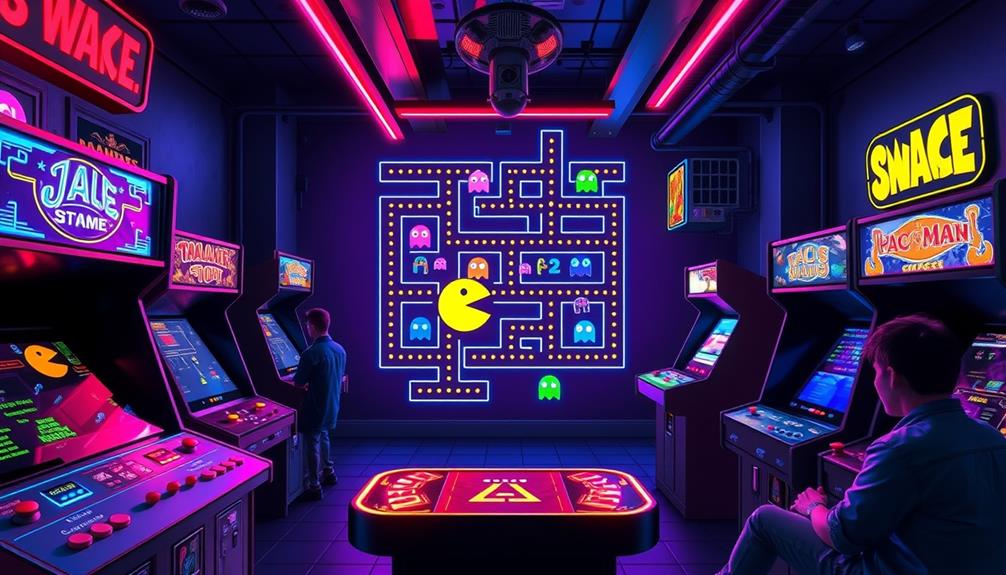
Revitalizing classic gameplay experiences taps into nostalgia while embracing modern innovation. You'll find that the revival of iconic arcade games like Pac-Man, enhanced through pixel art, creates a bridge between the past and present. This unique aesthetic simplifies details yet conveys emotions effectively, making pixel art perfect for breathing new life into classic video games.
Modern adaptations utilize advanced techniques like sub-pixel animation and parallax scrolling, transforming old favorites into immersive adventures. As you plunge into these reimagined worlds, you'll experience a seamless blend of retro charm and contemporary flair.
Consider these elements that contribute to revitalizing classic gameplay experiences:
- Nostalgic connections: Evoke fond memories from the 1980s and 1990s.
- Community engagement: Foster collaboration among developers and artists.
- Accessible tools: Enable indie developers to craft unique interpretations.
- Dynamic environments: Create rich, immersive gaming experiences.
Ultimately, as more indie developers embrace these techniques, you'll see a growing audience enthusiastic to engage with timeless gameplay, ensuring that classic video games remain relevant in today's gaming landscape.
Frequently Asked Questions
What Platforms Is "Pac-Man Pixel" Available On?
You can enjoy "Pac-Man Pixel" on various platforms, including PC, Nintendo Switch, PlayStation, and Xbox. Each platform offers unique features, so you'll want to choose the one that best fits your gaming style.
Is There Online Multiplayer in "Pac-Man Pixel"?
Yes, there's online multiplayer in "Pac-Man Pixel." You can team up or compete against friends, enhancing your gaming experience. Just connect online, and you're ready to enjoy some nostalgic fun with others!
Are There Any New Power-Ups Introduced in the Game?
Imagine a treasure chest bursting with surprises; you'll discover new power-ups in the game. These fresh additions enhance your strategy, letting you outsmart enemies and navigate mazes in exciting ways you haven't experienced before.
How Does "Pac-Man Pixel" Differ From the Original Pac-Man?
"Pac-Man Pixel" brings enhanced graphics, new gameplay mechanics, and diverse levels compared to the original. You'll experience fresh challenges, modernized controls, and vibrant visuals that elevate your nostalgic journey through the maze. Enjoy the upgrade!
Can I Customize My Pac-Man Character in the Game?
You can customize your Pac-Man character in the game. Just imagine running into a rainbow-colored ghost while you're munching on pellets. It's all about making your gaming experience uniquely yours! Enjoy the fun!
Conclusion
As you step into the vibrant world of pixel art, it's like rekindling a long-lost friendship, where nostalgia dances with innovation. The charming simplicity of Pac-Man invites you to navigate its maze, reliving the thrill of those early gaming days. With each dot you gobble, you're not just playing; you're part of a cultural tapestry that weaves together past and present. Embrace this pixelated adventure, and let the retro joy spark your imagination anew!



